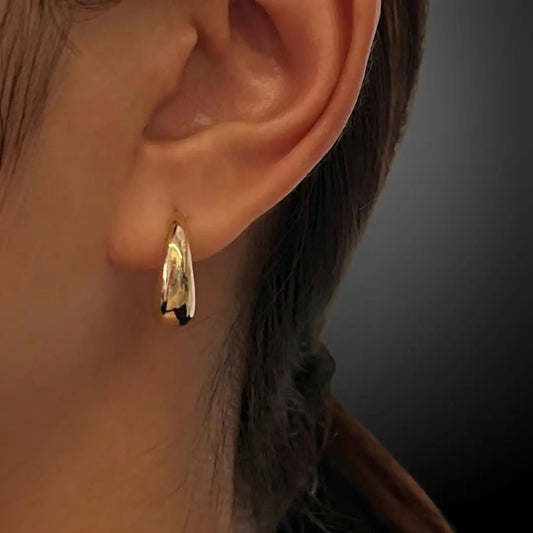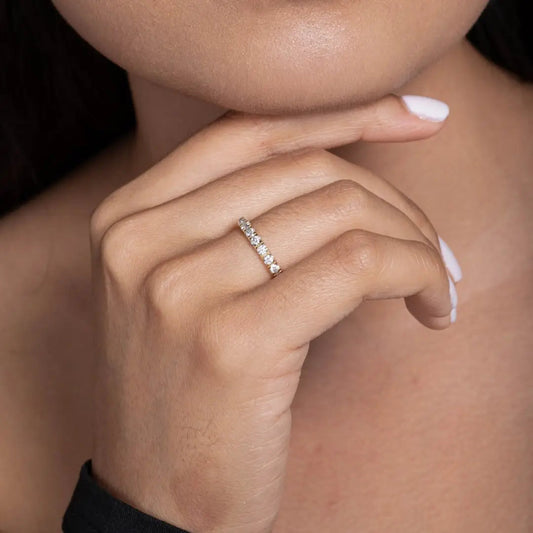Education: Solid Gold Guide
In the captivating world of fine jewelry, the gleam of 14K (also known as Au585) and 18K (Au750) solid gold stands as an emblem of timeless allure and lasting quality. From their radiant charm to their nuanced compositions, these gold varieties have captured the hearts of jewelry aficionados. In this guide, we delve into the intricacies of 14K and 18K solid gold, addressing your FAQs and illuminating the differences between solid gold, gold plating, and their purer counterparts.
Understanding the Gold Spectrum: 14K vs. 18K Solid Gold
14K Solid Gold: A Delicate Balance of Strength and Beauty
14K solid gold, renowned for its resilience, boasts an alloy composition of 58.3% pure gold, blended harmoniously with durable metals. This blend imparts a remarkable balance between strength and elegance, ensuring that your cherished pieces withstand the test of time. Notably, 14K solid gold often exhibits a delightful champagne hue, a tad more subdued than the vibrant yellow of higher purities.
18K Solid Gold: A Luxurious Embrace of Purity
18K solid gold takes purity to a higher level with an alloy composition of 75% pure gold. This blend grants a lustrous elegance, making 18K solid gold a luxurious choice for exquisite pieces. While slightly softer than 14K solid gold due to its increased gold content, 18K pieces showcase a refined and radiant appearance that's truly captivating.
A dive into Color Varieties
Gold, in its purest form, has a distinct yellow hue. However, the beauty of gold lies in its versatility. By alloying it with different metals, we can achieve a range of colors, each with its unique charm and character.
-
Yellow Gold: This is gold in its most classic form. The warm, rich hue of yellow gold is achieved by blending gold with metals like copper and zinc. It's timeless, traditional, and has been the gold standard (pun intended) for centuries.
-
White Gold: For those who lean towards the cool, understated elegance of silver, white gold is the answer. White gold is created by alloying pure gold with metals like palladium, silver, and sometimes a touch of platinum. This gives it a silvery-white hue. It's worth noting that white gold jewelry is often plated with rhodium, a member of the platinum family, to enhance its brightness and durability.
-
Rose Gold: The romantic allure of rose gold has made it increasingly popular in recent years. Its beautiful pinkish-red tint is achieved by blending gold with a higher proportion of copper. The more copper used, the redder the gold appears. It's a contemporary twist on traditional gold, offering a fresh and modern appeal.
Each of these gold varieties, while derived from the same base element, offers a different aesthetic. At EADN, we celebrate this diversity, ensuring that every individual finds a piece that resonates with their personal style and aesthetic preference. Read the blog for more on which one is more popular in the USA!
Solid Gold vs. Gold Plating: A Distinctive Difference
Solid gold differs vastly from gold plating. While solid gold encompasses the entire piece, retaining its brilliance over time, gold plating involves a thin layer of gold applied onto a base metal. The longevity and durability of solid gold make it a cherished investment, whereas gold plating may fade or wear off over time.
The Intricacies of 24K Pure Gold: Not Ideal for Jewelry
The allure of 24K pure gold, captivating as it is, isn't suitable for jewelry crafting due to its softness. Jewelry requires a certain level of durability to withstand the rigors of daily wear. The blend of other metals in 14K and 18K solid gold elevates their strength, allowing them to shine as resplendent symbols of elegance and endurance.
Caring for Your Solid Gold Jewelry: FAQs
How Durable is Solid Gold?
Solid gold, whether 14K or 18K, is designed to withstand everyday wear. Its alloy composition enhances its durability, ensuring that your pieces remain radiant for years. However, 18K solid gold may be slightly softer due to its higher gold content.
How Do I Clean and Care for Solid Gold Jewelry?
Cleaning your solid gold jewellery is simple. Gently wipe with a soft, lint-free cloth to remove dirt and oils. For a deeper clean, you can create a mild soapy solution using warm water and dish soap. Avoid harsh chemicals or abrasive materials. Proper storage in separate pouches or compartments also prevents scratches.
Can I Wear Solid Gold Jewelry Daily?
Absolutely! Solid gold's durability makes it perfect for daily wear. The material is safe with sweat, showers and can withstand 24/7 wear. Just be careful with delicate stone settings and delicate chains if you live a very active lifestyle. Whether you're adorning yourself with an elegant necklace or a cherished ring, solid gold jewellery offers enduring beauty that aligns with your lifestyle.
In Conclusion: A Symphony of Brilliance and Choice
In the realm of fine jewellery, the choice between 14K and 18K solid gold represents an exquisite spectrum of personal expression. Whether you're drawn to the timeless strength of 14K or the luxurious purity of 18K, each variety encapsulates a chapter of your unique story.
At EADN we embrace the nuances of gold varieties, offering a curated selection that resonates with your discerning taste. Our pieces are more than just adornments; they're reflections of your style, values, and an enduring connection to the brilliance of craftsmanship. As you wear these treasures, remember that the allure of gold goes beyond its shimmer - it's an embodiment of the brilliance that radiates from within.
Shop Bestsellers
-
Boho | Medium Tapered Hoop Earrings
Regular price $569.00 USDRegular priceUnit price / per -
Riviere | Pave Eternity Band
Regular price From $529.00 USDRegular priceUnit price / per -
Tiff | Solitaire Pendant Necklace
Round Brilliant CutRegular price From $689.00 USDRegular priceUnit price / per -
Bjorn | Knife Edge Bezel Necklace Emerald
Emerald CutRegular price From $649.00 USDRegular priceUnit price / per




